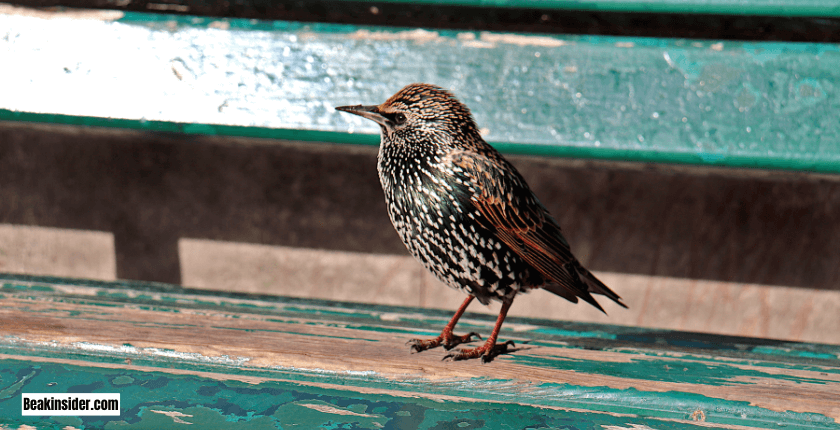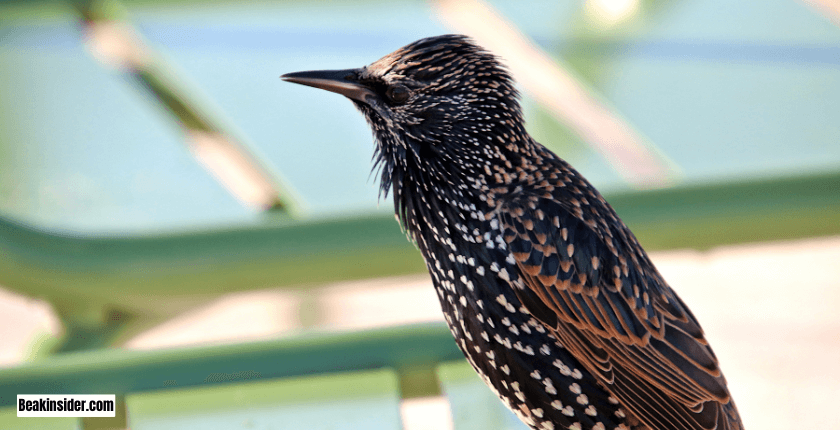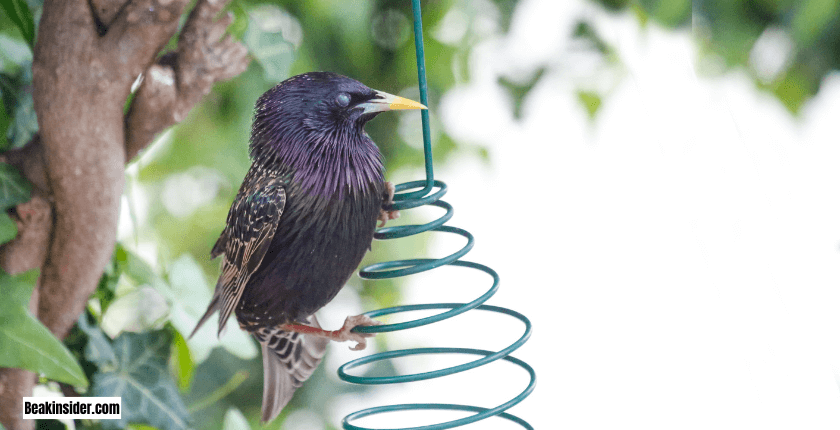Starlings are medium birds having shiny purple, green and bronze color feathers. They have short legs and flat feet. Their beak is around 10 inches long. They are known for having a striking appearance. They have a decent plumage with unique qualities. They captivate casual observers.
Starlings are members of the Sturnidae family. They are inhabitants of Asia, North America, Europe, Africa etc. Commonly we discuss European starlings. Its scientific name is Sturnus vulgaris. This bird is not only famous for their beauty, but also for its ability to adapt to different environments, ranging from rural farmlands to urban lands.
Let’s start without wasting time!
General Dimension of Starlings

Size and Shape
Sterling’s are medium birds with a compact body structure. I will tell you some details about their length, wingspan and weight.
- Length: Adult starlings are 7.59 inches or 19 cm long.
- Wingspan: Their wings are 40 cm long.
- Weight: Adult starlings usually weight around 3 to 3.5 ounces or 100 grams.
Body Structure
Starlings have pointed beaks and small rounded tails. Their body shape is streamlined providing them an agile flight. As a starling lover, I will tell you some great features of them.
- Head: Due to the small size of the head, they have a sleek appearance.
- Eyes: Starlings have round eyes and have dark color which makes them curious birds.
Vibrant Plumage
The most important factor for the attraction of starlings is their plumage which has incredible colors and exhibits different shades of beauty according to seasons and light conditions.
Plumage’s Color During Breeding Season
When the breeding season starts, starling shows different colors of plumage. Their looks become glossy and iridescent. Starlings exhibit unique characteristics during the breeding season, some of which are discussed below.
- Coloration: Starlings exhibit green blue and purple colors forming a shimmering effect and stunning look.
- Spots: During the breeding season, white or green colored spots appear on their skin, providing them an attractive and catchy look.
Plumage Color During Non-Breeding Season

In the non-breeding season, particularly during molting, their appearance changes. You will see color changes and spot visibility in them.
- Color Change: Their plumage color becomes fade and turns to gray colour.
- Spot Visibility: The spots may still be visible but are less pronounced than during the breeding season.
Juvenile Starlings – Famous Starling
Juvenile starlings have a completely different appearance compared to adults, which can be identified by the following features:
- Coloration: They are generally brown, lacking the iridescence of adult starlings.
- Size: Juveniles are similar in size to adults, but have shorter tails and less defined features.
Characteristics of Juvenile Starlings
Beak
Starlings possess distinctive beaks that are essential for their feeding habits.
- Shape: Their beaks are straight and conical, allowing them to forage efficiently.
- Color Variation: During the breeding season, male starlings may have brighter yellow beaks, which become darker after the season.
Eyes
Eyes are the prominent feature that includes beauty in their look.
- Color: They have a dark color eye providing them a striking contrast look.
- Size and Shape: Starlings have round-shaped eyes, giving them an attractive and inquisitive look and enhancing their beauty.
Legs and Feet
Starlings have structured their legs and feet to facilitate their perching activities and foraging behavior.
- Leg Color: Like many other birds, they have dull pink or grey-coloured short legs.
- Foot Structure: Starlings’ feet have a unique structure. It comprises 3 front-facing toes and one back-facing toe to help them grasp branches, wood, fences and other hard surfaces.
Social Behavior & Flocking of Starlings

You often see starlings in large flocks in the winter season. They are social birds. Their social behavior plays an important role in their survival and also in providing a striking appearance to them while flying in the sky.
Murmurations
During particular times in the year, starlings from a mesmerizing display named Murmuration. This phenomenon usually takes place, when starlings fly together in flocks in synchronised patterns. Here, I will tell you some important aspects of murmurations.
- Formation: While moving in different directions, they form stunning shapes, patterns and formations.
- Purpose: The most important purpose of murmuration is predator evasion. It also helps them in social interaction with their flock members.
Communication
Starlings have good vocal abilities making them capable of producing different sounds that include clicks, whistles and many other sounds of appliances. Vocalization plays an important part in the social structure of starlings.
- Contact Calls: They make specific calls to remain in contact with their flock members.
- Alarm Calls: They have special calls, you can name these calls as “Alarm calls” that help them in alerting potential threats.
Habitat and Distribution
Starlings have wide distribution due to their ability to thrive in different habitats. They are highly adaptable birds.
Urban Areas
- Nesting Areas: In cities, starlings are seen in nests in houses, and buildings and using artificial shelters.
- Feeding: In urban areas, starlings have wide opportunities to easily reach their food sources.
Farmlands
- Agricultural Areas: Starlings prefer to live in agricultural regions, due to the presence of insects, seeds and grains on which they rely for their food.
Woodlands
- Natural Habitats: Mostly starlings like to live in open areas, but they are also seen in woody areas near rivers, oceans, seas etc.
- Nest Sites: In woody lands, starlings make their nest in ledges and tree cavities. These natural resting areas provide safety.
Frequently Asked Questions (FAQs)
Are Starlings Invasive Species?
The answer is both yes and no. Starlings are found all around the world, but their population varies. In different areas of the world, starlings are considered an invasive species mainly in North America after the 19th century decreases in the population of starlings hurt native bird species as well as the ecosystem. Due to the decline in the population of starlings, conservation efforts were prioritized to manage their population and to balance the ecosystem.
On Which Food Items, Starlings Rely?
Starlings eat a wide range of food. They are omnivorous. Their feeding routine shows their adaptability.
- Starlings mainly rely on insects for their food. Besides eating insects, starlings will help in pest control in fields. They use foraging techniques to exactly locate insects.
- Starling also loves to eat different seeds, grains, berries, fruits and a few vegetables. Their feeding habits depend on the season in which they are thriving.
Conclusion
Starlings are beautiful birds with a lot of physical characteristics. They are popular for having beautiful plumage. They are social birds and have a joyful nature. They are found in woodlands, agricultural areas, near rivers, etc. It is important to know the behaviour of starlings to enhance visits of this beautiful bird to your garden. The presence of starlings in agricultural areas is advantageous as well as it sometimes causes serious damage to crops.
If you have any queries, text me in the comment box, and I will reply to you soon.
Thanks for reading!
Related Articles |
- Why Do Magpies Attack Eyes? Hidden Truth
- How To Attract Goldfinches? Catchy Ways To Attract Goldfinches
- How To Attract Hummingbirds?
- How To Remove Bird Poop From Your Car’s Paint?
- 12 Amazing Facts about Bald Eagles! – A Symbolic Representation!

I’m Amna, and I absolutely adore birds, especially parrots. I’ve been immersed in the world of these colorful feathered friends for over 10 years. While I’m not a bird doctor, I’ve gathered a wealth of knowledge on how to care for and understand them.
My experiences extend to various bird species like parrots, macaws, cockatoos, canaries, and finches. In addition to my personal adventures with birds, I’ve dedicated time to volunteering at a local bird rehabilitation center.
My true passion lies in sharing what I know about parrots and birds with you. Through my articles, I aim to share the information you need to provide the very best care for your avian companions. So, let’s embark on this journey together and make your feathered friends’ lives as joyful and healthy as possible!

